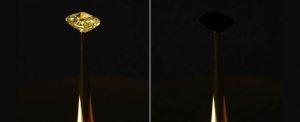You might think you already know black – even super-black Vantablack, previously the blackest material known to science – but researchers just came up with a material that takes black to a new level of blackness.
The new, as-yet-unnamed ultra-black material is made from vertically aligned carbon nanotubes (CNTs), microscopic carbon strings that are a little like a fuzzy forest of tiny trees, according to the team behind the project.
And here’s the rub – this CNT material can absorb more than 99.995 percent of incoming light, beating the 99.96 percent that Vantablack is able to absorb.
“In other words, it reflected 10 times less light than all other superblack materials, including Vantablack,” explains an MIT release.
Like some of the best scientific discoveries, this record-setting black stuff was discovered by accident.

The researchers were looking at ways to grow CNTs on electrically conductive materials like aluminium, and it was during these experiments that they noticed the blackness of the materials they were growing on specially treated aluminium foil.
“I remember noticing how black it was before growing carbon nanotubes on it, and then after growth, it looked even darker,” says mechanical engineer Kehang Cui, from Shanghai Jiao Tong University in China. “So I thought I should measure the optical reflectance of the sample.”
That’s when the ultra-powerful light absorption properties were recorded – from every possible angle, the material soaked up virtually all the light directed at it.
Ask me anything
Explore related questions





